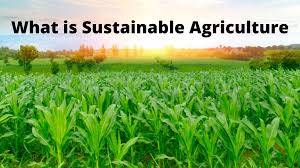QUESTIONS AND ANSWERS :SUSTAINABLE AGRICULTURE
1a. Explain the concept of greening TVET.
b. What is the significance of greening TVET institutions?
c. Explain how greening TVET institutions benefits the learner and the society as a whole.
d. What is ESD as applied in greening TVET institutions.
e. State the approaches by which ESD can be implemented in TVET institutions.
2 a. State 3 reasons why there is the need for sustainable water resource management to increase water supply in food and agriculture.
b. State 3 agricultural practices that can lead to water contamination in the environment.
c. Explain the concept of sanitation.
d. Explain the following types of sanitation;
i. Basic sanitation.
ii. Container based sanitation.
e. State the two main objectives of sanitation.
3a. State the difference between sustainable land preparation and sustainable land use.
b. Explain the following sustainable land preparation techniques;
i. Zero burning
ii. Crop rotation
iii. Crop diversification
iv. Controlled grazing
4a. What are agricultural biodegradable wastes?
b. Explain the following classes of agricultural wastes and give 2 examples of each;
i. Animal production solid wastes.
ii. Crop production solid wastes.
iii. Food and meat processing solid wastes
a. Explain 3 effective ways by which agricultural solid wastes can be managed.
5a. Explain 4 sources of agricultural non-biodegradable wastes.
b. State 3 differences between biodegradable and non-biodegradable wastes.
c. Explain 3 side effects of non-biodegradable wastes.
6a. Explain 4 ways by which farm tools, equipment and machines can be maintained.
b. State 4 importance of care and maintenance of farm tools, equipment and machines.
c. Explain 2 storage practices of farm tools, equipment and machines.
7a. Explain the term ‘Ethno-veterinary medicine’
b. state 2 herbal products for
i. the control of worms in farm animals.
ii. Storage of crops, e.g. maize.
c. State 4 advantages of the use of Ethno-veterinary medicine over synthetic chemicals in agriculture.
8a. what are agro-chemicals?
b. Explain the following types of agro-chemicals and give 2 examples of each;
i. Soil conditioners.
ii. Liming materials and acidifying agents.
iii. Fertilizers.
9a. Explain the term ‘plant growth regulators’
b. State 2 functions each of the following plant growth regulators;
i. Auxins
ii. Gibberellins
iii. Cytokinins
iv. Ethylene
c. Explain 3 negative effects of excessive use of agro-chemicals within
i. the agricultural system
ii. the environment
d. State 2 ways of minimizing the negative effects of a
gro-chemicals application on the environment.
SUSTAINABLE SCHEME
1a. Greening TVET entails integrating environmentally sustainable practices into Technical and Vocational Education and Training institutions, emphasizing eco-friendly skills.
b. Greening TVET institutions is significant for fostering environmental responsibility, preparing students for sustainable job opportunities, and contributing to overall ecological balance.
c. Learners benefit from greening TVET by acquiring skills aligned with environmental sustainability, while society gains a skilled workforce promoting eco-conscious practices and sustainable development.
d. ESD in greening TVET involves embedding sustainability principles into education, promoting awareness, and encouraging responsible environmental practices.
e. ESD implementation in TVET includes curriculum integration, engaging communities in sustainable projects, and incorporating eco-friendly practices within institutional operations.
2a. Reasons for sustainable water resource management in agriculture include ensuring long-term water availability, enhancing crop yields, and preserving ecosystems for sustainable food production.
b. Agricultural practices leading to water contamination encompass excessive pesticide use, improper fertilizer application, and inadequate disposal of agricultural waste.
c. Sanitation involves providing facilities and services for the safe disposal of human waste, maintaining hygiene, and preventing the spread of diseases.
d.
i. Basic sanitation focuses on providing accessible and hygienic human waste disposal facilities.
ii. Container-based sanitation utilizes portable containers for efficient waste collection, especially in areas with limited infrastructure.
e. The two main objectives of sanitation are to protect public health by ensuring proper waste disposal and to preserve the environment by preventing pollution.
3a. Sustainable land preparation emphasizes eco-friendly practices before cultivation, while sustainable land use involves responsible and efficient land resource utilization over time.
b.
i. Zero burning avoids the use of fire in land preparation, reducing air pollution and preserving soil fertility.
ii. Crop rotation enhances soil health by alternating different crops, preventing nutrient depletion.
iii. Crop diversification promotes biodiversity and reduces the risk of crop failure.
iv. Controlled grazing involves managing livestock grazing to prevent overgrazing and land degradation.
4a. Agricultural biodegradable wastes refer to organic materials generated in farming activities that can naturally decompose, contributing to nutrient cycling in ecosystems.
b.
i. Animal production solid wastes: Examples include manure (animal excrement) and bedding materials (straw or hay).
ii. Crop production solid wastes: Examples encompass crop residues (stalks, leaves) and discarded plant materials.
iii. Food and meat processing solid wastes: Examples involve vegetable peels and discarded meat trimmings.
a. Effective ways to manage agricultural solid wastes include composting (turning organic waste into nutrient-rich compost), recycling (reusing materials), and using them for bioenergy production.
5a. Agricultural non-biodegradable wastes originate from farming activities and do not decompose naturally. Sources include plastic packaging, synthetic pesticide containers, and discarded agrochemical containers.
b. Differences between biodegradable and non-biodegradable wastes:
i. Biodegradable wastes can break down naturally, while non-biodegradable wastes persist in the environment.
ii. Biodegradable wastes contribute to nutrient cycling, while non-biodegradable wastes accumulate and pose pollution risks.
iii. Biodegradable wastes are typically organic, while non-biodegradable wastes are synthetic or inorganic.
c. Side effects of non-biodegradable wastes include soil pollution, water contamination, and harm to wildlife due to ingestion or entanglement.
6a. Ways to maintain farm tools, equipment, and machines include regular cleaning, proper storage, lubrication, and timely repairs.
b. Importance of care and maintenance:
i. Extends the lifespan of tools, equipment, and machines.
ii. Ensures efficient and effective performance.
iii. Reduces operational downtime.
iv. Enhances safety for users.
c. Storage practices for farm tools, equipment, and machines involve keeping them in a dry place and protecting them from exposure to harsh weather conditions.
7a. Ethno-veterinary medicine refers to traditional knowledge and practices used by communities to treat and prevent diseases in animals.
b.
i. Herbal products for the control of worms in farm animals: Neem leaves and garlic.
ii. Herbal products for crop storage (e.g., maize): Dry neem leaves and tobacco leaves.
c. Advantages of ethno-veterinary medicine over synthetic chemicals:
i. Cost-effectiveness.
ii. Cultural acceptance.
iii. Lower environmental impact.
iv. Availability of local resources.
8a. Agro-chemicals are chemical substances used in agriculture for various purposes, such as pest control, soil fertility improvement, and plant growth regulation.
8b. Types of agro-chemicals and examples:
i. **Soil conditioners:** These are substances that enhance the physical and chemical properties of the soil. Examples include gypsum (to improve soil structure) and organic matter (such as compost or manure).
ii. **Liming materials and acidifying agents:** Liming materials, like limestone, are used to raise soil pH, while acidifying agents, such as sulfur, are employed to lower soil pH, ensuring optimal conditions for plant growth.
iii. **Fertilizers:** Fertilizers provide essential nutrients to plants for healthy growth. Examples include nitrogen-based fertilizers like urea and phosphorus-based fertilizers such as superphosphate.
b.
i. Soil conditioners: Gypsum and organic matter.
ii. Liming materials and acidifying agents: Limestone and sulfur.
iii. Fertilizers: Nitrogen-based (e.g., urea) and phosphorus-based (e.g., superphosphate).
9a. Plant growth regulators are chemicals that influence the growth and development of plants.
b. Functions of plant growth regulators:
i. Auxins: Promote cell elongation and root development.
ii. Gibberellins: Stimulate stem elongation and seed germination.
iii. Cytokinins: Regulate cell division and influence lateral bud growth.
iv. Ethylene: Coordinates fruit ripening and promotes leaf and flower abscission.
c. Negative effects of excessive agro-chemical use:
i. Agricultural system: Soil degradation and development of resistant pests.
ii. Environment: Water pollution and disruption of ecosystem balance.
d. Ways to minimize negative effects on the environment include a
dopting integrated pest management (IPM) practices and using precision agriculture techniques.


